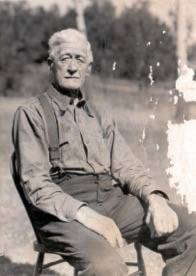© 2019 Michael Riis-Christianson and the Lakes District Museum Society
Jacob Henkel was one of this area’s first pioneers. Originally from the United States, he heard about the beauty of the Lakes District while returning from the Yukon, where (like thousands of others) he’d been prospecting and trapping. Intent on homesteading in Canada, he obtained British citizenship before taking ship to Bella Coola.
Henkel purchased 10 packhorses in the remote coastal community, and together with George Culp, headed northeast on the Ulkatcho trail, a trading route established by interior’s indigenous people.
It was a difficult journey fraught with danger. The route, which took the two men and their pack train over the Coast Range and through the wilds of what is now Tweedsmuir Park, was so steep and narrow in places that a single misstep would have spelled disaster. Dozens of frigid rivers barred their passage in low-lying areas, and grizzly bears were an ever-present threat.
The two pioneers persevered, reaching Ootsa Lake in 1904. Jacob Henkel settled on the north shore of Ootsa Lake, where he staked a half-section of land, built a cabin, and prepared to spend the winter. His travelling partner, George Culp, returned to Bella Coola.
For a time, Henkel had the area to himself. In late fall, though, he had his first contact with the area’s indigenous people. Skin Tyee, a well-known individual who lived near Skins Lake, arrived on Henkel’s doorstep and ordered him to leave the country. Henkel, a large and powerful man who spoke Chinook, made it clear both verbally and physically that he had no intention of vacating the premises. After the incident, the men became friends, often sharing meat and meals.
Henkel spent the winter of 1904-05 exploring the region. His travels brought him into contact with the Cheslatta people and Chief Louis. On another trip, he followed trails to the head of Francois Lake.
Culp returned in the spring of 1905 with Hank Snodgrass. Not long after, the surveying party led by Edward Pomeroy Colley brought news that a railway would be constructed through Northern BC. Hearing this, Henkel decided to abandon his homestead on Ootsa and relocate closer to the route of the proposed rail line.
Culp and Henkel cut a trail from Takysie Lake to the south shore of Francois Lake, and there built a raft to ferry their supplies to the north side. Henkel promptly staked two quarter sections of land there, one of which was near a small lake. He built a rough cabin and cache in which to store his supplies, and started clearing land for a farm. He brought the first metal plow into the Francois Lake area by packhorse, and later went to work with the survey crew at Colleymount.
Within a few years, Henkel converted his cabin into a blacksmith shop and had built a new, two-room home. When the Grand Trunk Pacific Railway was completed in 1914, he brought in modern furnishings for it – a rare occurrence at a time when most items of this type were knocked together from locally available materials.
By 1916, Jacob Henkel had been appointed Justice of the Peace for the Francois Lake area. He met his future wife, Johanna Christensen, at about the same time when she came to the area to visit a friend. The couple was married in the new log church at Francois Lake.
Over the course of his long life, Henkel served as secretary of the school board and president of the Francois Lake Hospital Society. He was active in community affairs and held in high esteem by local residents.
One story is testament to the man’s character. It’s said that while hunting with three friends, Henkel accidentally shot a man named Max Ewart. Determined to save the wounded hunter, Henkel placed him in a canoe, then poled and rowed down the Stellako, Nechako, and Fraser rivers to the hospital at Soda Creek. It was a feat never duplicated, but it saved Ewart’s life.
Henkel retired in the 1930s and turned his farm over to his son-in-law. He died in the mid-1940s. In 1949, the provincial government paid homage to this dignified gentleman by naming its new Francois Lake ferry after him. Like its namesake, the vessel served the community well for decades.
